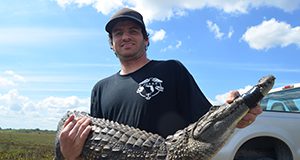Non-native reptile species breeding in Florida, tegus, monitors, and iguanas from Africa, South America, Central America, and Mexico, currently outnumber native Florida reptiles. This trifold brochure written by Justin Dalaba and Frank Mazzotti and published by the UF/IFAS Wildlife Ecology and Conservation Department serves as a guide to several commonly confused species.
http://edis.ifas.ufl.edu/uw459
Tag: Frank Mazzotti
Everglades Invasive Reptile and Amphibian Monitoring Program: Summary of the First Five Years
South Florida has more nonnative species of reptiles and amphibians than anywhere else in the world. Some of these species become invasive and harm the environment, economy, and/or public health. Once populations are widely established, management becomes expensive, long-term, and often ineffective. Early detection and rapid response offers the best chance to contain or eradicate populations before they can spread and become unmanageable. Toward that end, the Everglades Invasive Reptile and Amphibian Monitoring Program provides a scientific framework for monitoring invasive reptiles and amphibians in south Florida. It also monitors native reptiles, amphibians, and mammals to assess impacts of invasive species.
This 5-page fact sheet written by Rebecca G. Harvey, Mike Rochford, Jennifer Ketterlin Eckles, Edward Metzger III, Jennifer Nestler, and Frank J. Mazzotti and published by the Wildlife Ecology and Conservation Department lists the objectives, activities, and accomplishments of the program over its first five years, and it describes some ways Floridians and visitors to the state can help with the effort.
http://edis.ifas.ufl.edu/uw431
Freshwater Fish of New River, Belize
Belize is home to an abundant diversity of freshwater fish species and is often considered a fishing paradise. The New River area is a popular freshwater fishing destination in the Orange Walk district of northern Belize. Here locals and visitors alike take to the lagoons and waterways for dinner or for good sportfishing. This 3-page guide written by Venetia Briggs-Gonzalez, Kyle Allen, and Frank J. Mazzotti and published by the Wildlife Ecology and Conservation Department highlights the most popular species in the area and will help people identify and understand these species.
http://edis.ifas.ufl.edu/uw406


